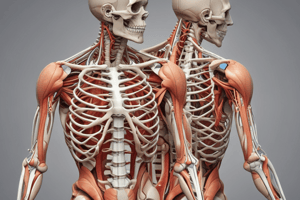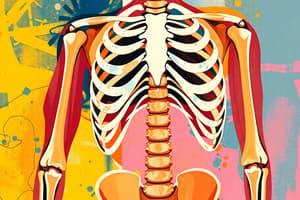Podcast
Questions and Answers
Which of the following is the primary function of the musculoskeletal system?
Which of the following is the primary function of the musculoskeletal system?
- Providing structure and facilitating movement. (correct)
- Filtering waste products from the blood.
- Producing hormones for various bodily functions.
- Regulating body temperature through sweat glands.
What is the role of osteoblasts in bone tissue?
What is the role of osteoblasts in bone tissue?
- Forming bone tissue. (correct)
- Degrading bone tissue.
- Storing calcium within the bone.
- Producing red blood cells.
Which type of tissue primarily composes bones?
Which type of tissue primarily composes bones?
- Muscle tissue.
- Adipose tissue.
- Epithelial tissue.
- Osseous tissue. (correct)
What is the periosteum's primary function?
What is the periosteum's primary function?
Which type of bone is the humerus considered to be?
Which type of bone is the humerus considered to be?
Approximately how many skeletal muscles are in the human body?
Approximately how many skeletal muscles are in the human body?
What connects skeletal muscles to bones?
What connects skeletal muscles to bones?
What is the definition of abduction in terms of body movement?
What is the definition of abduction in terms of body movement?
In the context of bone composition, what is the primary difference between compact bone and spongy bone?
In the context of bone composition, what is the primary difference between compact bone and spongy bone?
Which of the following is NOT a function of bones?
Which of the following is NOT a function of bones?
Which of the following is an example of a flat bone?
Which of the following is an example of a flat bone?
What are the long muscle fibers that compose skeletal muscles called?
What are the long muscle fibers that compose skeletal muscles called?
Which of the following is NOT a type of muscle tissue?
Which of the following is NOT a type of muscle tissue?
What is the total number of bones that comprise the axial skeleton?
What is the total number of bones that comprise the axial skeleton?
Which of the following is an example of an irregular bone?
Which of the following is an example of an irregular bone?
What is the name of cells that produce red blood cells in bone marrow?
What is the name of cells that produce red blood cells in bone marrow?
What is the main component of yellow marrow?
What is the main component of yellow marrow?
Which of the following provides nourishment and formation of bones?
Which of the following provides nourishment and formation of bones?
Flashcards
Musculoskeletal system
Musculoskeletal system
Bones, muscles, and joints providing structure and movement, controlled by the nervous system.
Functions of bones
Functions of bones
Provide structure and protection, act as levers, store calcium, and produce blood cells.
Total number of bones
Total number of bones
The 206 bones divided into the axial and appendicular skeleton.
Compact bone
Compact bone
Signup and view all the flashcards
Spongy bone
Spongy bone
Signup and view all the flashcards
Osteoblasts
Osteoblasts
Signup and view all the flashcards
Osteoclasts
Osteoclasts
Signup and view all the flashcards
Periosteum
Periosteum
Signup and view all the flashcards
Types of muscles
Types of muscles
Signup and view all the flashcards
Tendons
Tendons
Signup and view all the flashcards
Abduction
Abduction
Signup and view all the flashcards
Adduction
Adduction
Signup and view all the flashcards
Study Notes
- The body's bones, muscles, and joints make up the musculoskeletal system.
- The nervous system controls and innervates the musculoskeletal system.
- The musculoskeletal system provides structure and movement for body parts.
Bones
- Bones provide structure, protection, act as levers, store calcium, and produce blood cells.
- The human body has 206 bones.
- The axial skeleton includes the head and trunk.
- The appendicular skeleton includes the extremities, shoulders, and hips.
- Bones consist of osseous tissue.
- Compact bone is hard and dense, forming the shaft and outer layers of bones.
- Spongy bone contains spaces and makes up the ends and centers of bones.
- Osteoblasts are active cells that form bone tissue.
- Osteoclasts are cells that degrade bone tissue.
- Red marrow produces blood cells
- Yellow marrow consists mostly of fat.
- The periosteum covers bones and contains osteoblasts and blood vessels for nourishment and new bone tissue formation.
- Bones have various shapes, including short (carpals), long (humerus, femur), flat (sternum, ribs), and irregular (hips, vertebrae) bones.
Skeletal Muscles
- The body consists of skeletal, smooth, and cardiac muscles.
- The musculoskeletal system includes 650 skeletal (voluntary) muscles under conscious control.
- Skeletal muscles consist of long muscle fibers (fasciculi) arranged in bundles and joined by connective tissue.
- Tendons are strong, fibrous cords that attach skeletal muscles to bones.
- Skeletal muscles assist with posture, produce body heat, and enable movement.
- Abduction involves moving away from the midline of the body.
- Adduction involves moving toward the midline of the body.
Studying That Suits You
Use AI to generate personalized quizzes and flashcards to suit your learning preferences.




